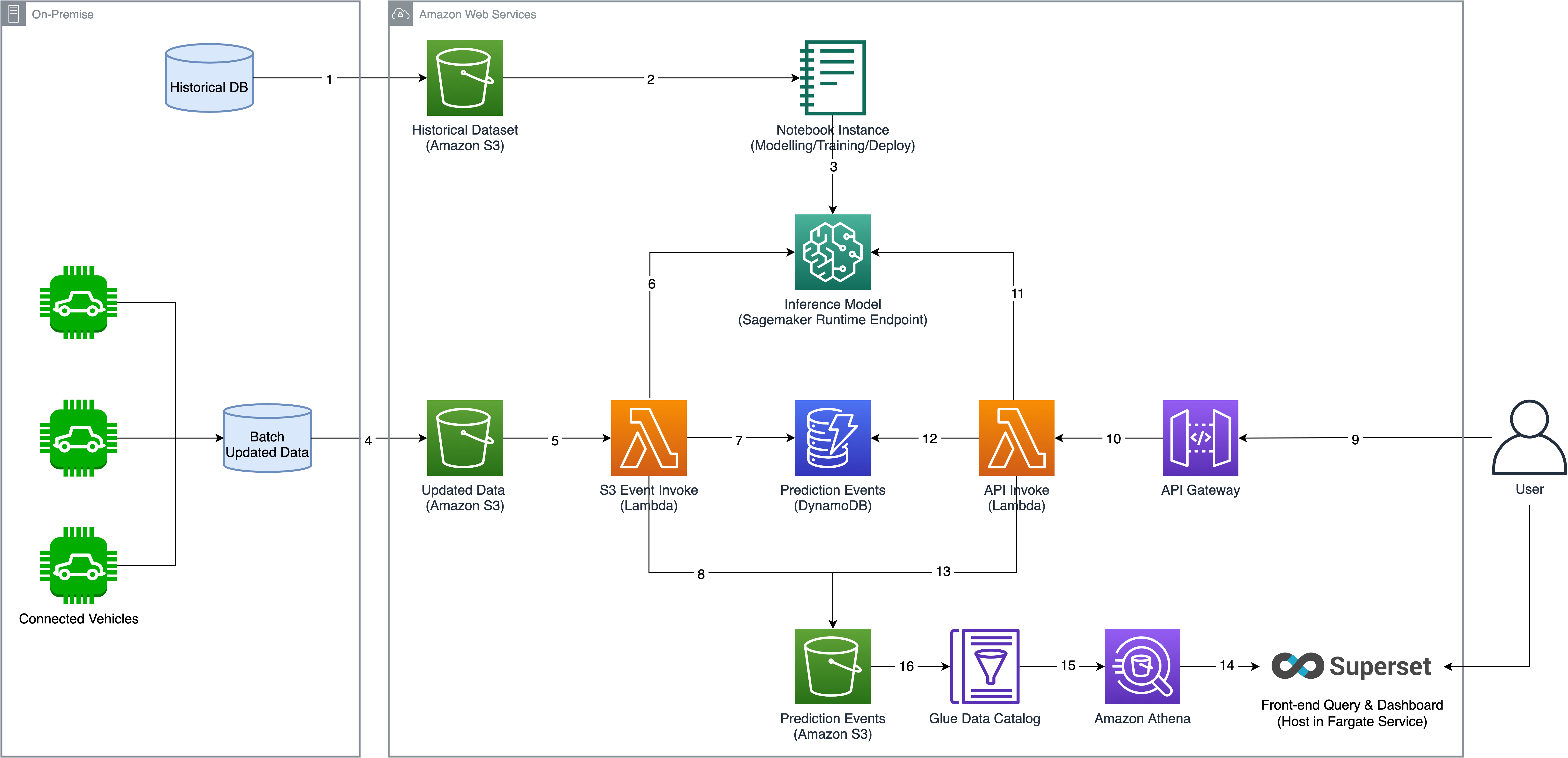With Amazon S3, Amazon Lambda, Amazon SageMaker, Amazon DynamoDB and open-source Apache Superset, this solution offers machine learning developers and data scientists an entire tool chain for battery consistency bias alarm prediction in Battery Management System (BMS), including data storage, data analysis, feature engineering, model building, model training/inference and data visualization. This solution offers smooth work flow in the cloud without infrastructure capacity concerning, makes it easier to securely manage terabytes of data for battery and connected vehicle data to store and scale parallel algorithm training workloads to hundreds of cores in short time. It allows Original Equipment Manufacturer (OEM) to speed up developing process. Based on more BEV operation data, OEM can make more data analytics in different scenarios, for example, charging data, etc. "We need a tool chain to help us deal with data process and predicting." Said Kevin, Connected Vehicle Leader, Customer Digital Department in Volvo APAC. "This solution allows us to build an alert prediction platform in AWS with lacking of data analysis and scientists and obtain the expected result in POC."
Detail process is described as below:
- OEM or BEV battery vendors store battery data (captured with IoT, etc.) in S3 bucket.
- Sagemaker notebook instance obtain dataset from S3 bucket, which could be used for model training.
- Complete model building, model training and model deployment. It outputs a runtime endpoint, which is used to provide inference service.
- Scenario 1: connected vehicles upload battery data (batch data) to S3 bucket.
- Scenario 1: S3 bucket create event invoke lambda function.
- Scenario 1: lambda function invokes the deployed sagemaker endpoint, perform inference on the uploaded batch data.
- Scenario 1: batch inference results are written into dymanodb.
- Scenario 1: batch inference results are written into S3 for superset visualization.
- Scenario 2: user invokes the prediction service via HTTP POST request.
- Scenario 2: API gateway route the request to lambda function.
- Scenario 2: lambda function invokes the deployed sagemaker endpoint, perform inference with the post data as input.
- Scenario 2: API single inference results are written into dymanodb.
- Scenario 2: API single inference results are written into S3 for superset visualization.
- Superset is host with Fargate service, users can access inference results using SQL query.
- Athena query inference events from Glue Data Catalog.
- The table defined in Glue Data Catalog describes the schema of inference events which are stored in S3 bucket.
- The deployment will automatically provision resources like S3, API Gateway, Lambda, Dynamodb table, ECS Fargate Service, Sagemaker notebook, Glue Data Catalog table in your AWS account, etc.
- The deployment will take approximately 5-10 minutes.
The following is the parameter for deployment:
| Parameter | Default | Description |
|---|---|---|
| sagemakerEndpointName | battery-consistency-bias-alarm-prediction-endpoint | Sagemaker runtime endpoint, should be same with the configuration in Sagemaker notebook script. |
Please follow below steps to deploy this solution via AWS Cloudformation.
-
Sign in to AWS Management Console, switch to the region to deploy the CloudFormation Stack to.
-
Click the following button to launch the CloudFormation Stack in that region.
- For Standard Partition
- For China Partition
-
Click Next. Change the stack name if required.
-
Click Next. Configure additional stack options such as tags (Optional).
-
Click Next. Review and confirm acknowledgement, then click Create Stack to start the deployment.
Note: You can simply delete the stack from CloudFormation console if this solution is no longer required.
If you want to use AWS CDK to deploy this solution, please make sure you have met below prerequisites:
- AWS Command Line Interface
- Node.js 12.x or later
Under the project source folder, run below to compile TypeScript into JavaScript.
cd source
npm install -g aws-cdk
npm install && npm run build
Then you can run cdk deploy command to deploy the solution. Please specify the parameter value if needed, for example:
cdk deploy --parameters sagemakerEndpointName=<your_sagemaker_runtime_endpoint>
Note: You can simply run
cdk destroyif the solution task is no longer required. This command will remove the stack created by this solution from your AWS account.
See CONTRIBUTING for more information.
This library is licensed under the MIT-0 License. See the LICENSE file.
